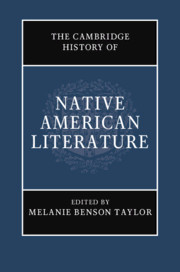Book contents
- The Cambridge History of Native American Literature
- The Cambridge History of Native American Literature
- Copyright page
- Contents
- Figures
- Contributors
- Introduction: What Was Native American Literature?
- Part I Traces and Removals (Pre-1870s)
- Part II Assimilation and Modernity (1879–1967)
- Part III Native American Renaissance (Post-1960s)
- 14 Rethinking the Native American Renaissance: Texts and Contexts
- 15 Marginally Mainstream: Momaday, Silko, Erdrich, and Alexie
- 16 Indigenous Lives, Visual Autobiographies
- 17 Indigenous Writing in Canada
- 18 Reservation Realities and Myths in American Literary History
- 19 Mapping the Future: Indigenous Feminism
- 20 Queer Sovereignty
- 21 Contemporary Indigenous American Poetry
- 22 Contemporary Native North American Drama
- Part IV Visions and Revisions: 21st-Century Prospects
- Index
- References
16 - Indigenous Lives, Visual Autobiographies
from Part III - Native American Renaissance (Post-1960s)
Published online by Cambridge University Press: 18 September 2020
- The Cambridge History of Native American Literature
- The Cambridge History of Native American Literature
- Copyright page
- Contents
- Figures
- Contributors
- Introduction: What Was Native American Literature?
- Part I Traces and Removals (Pre-1870s)
- Part II Assimilation and Modernity (1879–1967)
- Part III Native American Renaissance (Post-1960s)
- 14 Rethinking the Native American Renaissance: Texts and Contexts
- 15 Marginally Mainstream: Momaday, Silko, Erdrich, and Alexie
- 16 Indigenous Lives, Visual Autobiographies
- 17 Indigenous Writing in Canada
- 18 Reservation Realities and Myths in American Literary History
- 19 Mapping the Future: Indigenous Feminism
- 20 Queer Sovereignty
- 21 Contemporary Indigenous American Poetry
- 22 Contemporary Native North American Drama
- Part IV Visions and Revisions: 21st-Century Prospects
- Index
- References
Summary
As part of the ongoing project of decolonization and cultural critique, indigenous artists and writers take on the role of autobiographers, ethnographers, historians, activists, and visionaries, often in the form of visual autobiography. Their storytelling crosses fields of study (art practice, history, anthropology, and literature), media (text, photographs, drawings, paintings, and maps), as well as geographies and cultures. Collectively they bear witness to transgenerational trauma, challenge official settler-colonial myths, share tribal stories and epistemologies as well as personal narratives, and insist on indigenous presence, witness, and continuity. This essay traces indigenous visual self-narrative forms from pre-contact pictography to ledger book art to their adaptation into contemporary modes as well as the indigenization of Western forms such as comics and memoir. Two streams—one arising from and referring to earlier pictography and a second arising from Western literary or artistic traditions, but with indigenous inflections—are discussed.
Keywords
- Type
- Chapter
- Information
- The Cambridge History of Native American Literature , pp. 287 - 326Publisher: Cambridge University PressPrint publication year: 2020
References
- 1
- Cited by



